计算机网络_自顶向下方法_(中文版课件)第八章_网络安全.TopDownV3-8
- 格式:ppt
- 大小:1.19 MB
- 文档页数:89
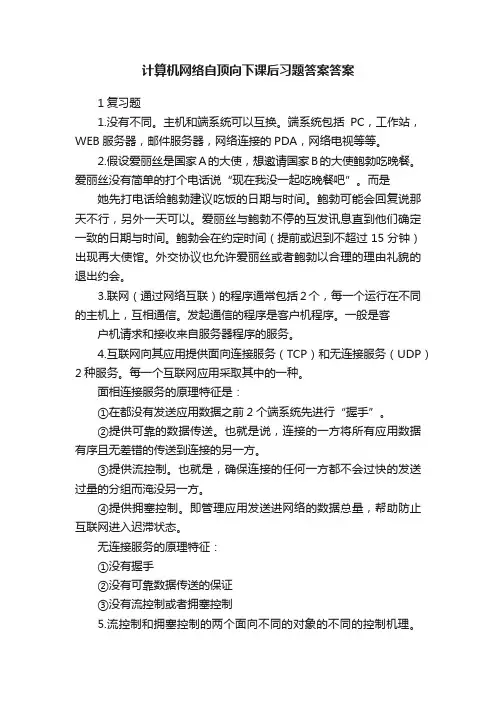
计算机网络自顶向下课后习题答案答案1复习题1.没有不同。
主机和端系统可以互换。
端系统包括PC,工作站,WEB服务器,邮件服务器,网络连接的PDA,网络电视等等。
2.假设爱丽丝是国家A的大使,想邀请国家B的大使鲍勃吃晚餐。
爱丽丝没有简单的打个电话说“现在我没一起吃晚餐吧”。
而是她先打电话给鲍勃建议吃饭的日期与时间。
鲍勃可能会回复说那天不行,另外一天可以。
爱丽丝与鲍勃不停的互发讯息直到他们确定一致的日期与时间。
鲍勃会在约定时间(提前或迟到不超过15分钟)出现再大使馆。
外交协议也允许爱丽丝或者鲍勃以合理的理由礼貌的退出约会。
3.联网(通过网络互联)的程序通常包括2个,每一个运行在不同的主机上,互相通信。
发起通信的程序是客户机程序。
一般是客户机请求和接收来自服务器程序的服务。
4.互联网向其应用提供面向连接服务(TCP)和无连接服务(UDP)2种服务。
每一个互联网应用采取其中的一种。
面相连接服务的原理特征是:①在都没有发送应用数据之前2个端系统先进行“握手”。
②提供可靠的数据传送。
也就是说,连接的一方将所有应用数据有序且无差错的传送到连接的另一方。
③提供流控制。
也就是,确保连接的任何一方都不会过快的发送过量的分组而淹没另一方。
④提供拥塞控制。
即管理应用发送进网络的数据总量,帮助防止互联网进入迟滞状态。
无连接服务的原理特征:①没有握手②没有可靠数据传送的保证③没有流控制或者拥塞控制5.流控制和拥塞控制的两个面向不同的对象的不同的控制机理。
流控制保证连接的任何一方不会因为过快的发送过多分组而淹没另一方。
拥塞控制是管理应用发送进网络的数据总量,帮助防止互联网核心(即网络路由器的缓冲区里面)发生拥塞。
6.互联网面向连接服务通过使用确认,重传提供可靠的数据传送。
当连接的一方没有收到它发送的分组的确认(从连接的另一方)时,它会重发这个分组。
7.电路交换可以为呼叫的持续时间保证提供一定量的端到端的带宽。
今天的大多数分组交换网(包括互联网)不能保证任何端到端带宽。
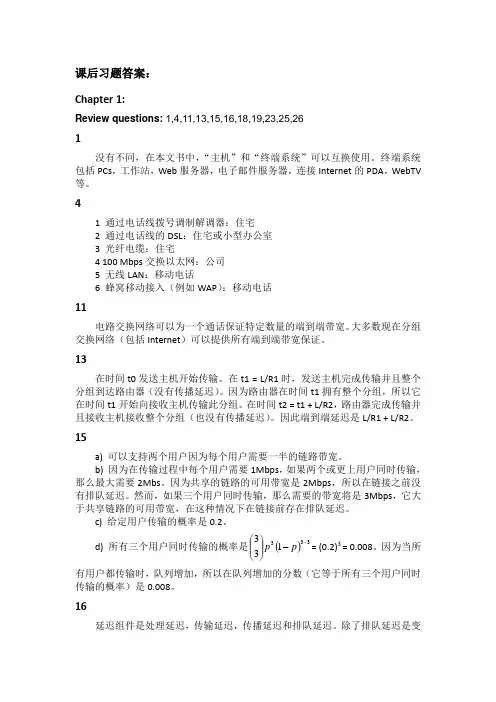
课后习题答案:Chapter 1:Review questions: 1,4,11,13,15,16,18,19,23,25,261没有不同,在本文书中,“主机”和“终端系统”可以互换使用。
终端系统包括PCs ,工作站,Web 服务器,电子邮件服务器,连接Internet 的PDA ,WebTV 等。
41 通过电话线拨号调制解调器:住宅2 通过电话线的DSL :住宅或小型办公室3 光纤电缆:住宅4 100 Mbps 交换以太网:公司5 无线LAN :移动电话6 蜂窝移动接入(例如WAP ):移动电话11电路交换网络可以为一个通话保证特定数量的端到端带宽。
大多数现在分组交换网络(包括Internet )可以提供所有端到端带宽保证。
13在时间t0发送主机开始传输。
在t1 = L/R1时,发送主机完成传输并且整个分组到达路由器(没有传播延迟)。
因为路由器在时间t1拥有整个分组,所以它在时间t1开始向接收主机传输此分组。
在时间t2 = t1 + L/R2,路由器完成传输并且接收主机接收整个分组(也没有传播延迟)。
因此端到端延迟是L/R1 + L/R2。
15a) 可以支持两个用户因为每个用户需要一半的链路带宽。
b) 因为在传输过程中每个用户需要1Mbps ,如果两个或更上用户同时传输,那么最大需要2Mbs 。
因为共享的链路的可用带宽是2Mbps ,所以在链接之前没有排队延迟。
然而,如果三个用户同时传输,那么需要的带宽将是3Mbps ,它大于共享链路的可用带宽,在这种情况下在链接前存在排队延迟。
c) 给定用户传输的概率是0.2。
d) 所有三个用户同时传输的概率是()333133--⎪⎪⎭⎫ ⎝⎛p p = (0.2)3 = 0.008。
因为当所有用户都传输时,队列增加,所以在队列增加的分数(它等于所有三个用户同时传输的概率)是0.008。
16延迟组件是处理延迟,传输延迟,传播延迟和排队延迟。
除了排队延迟是变化的,其它所有延迟都是固定的。
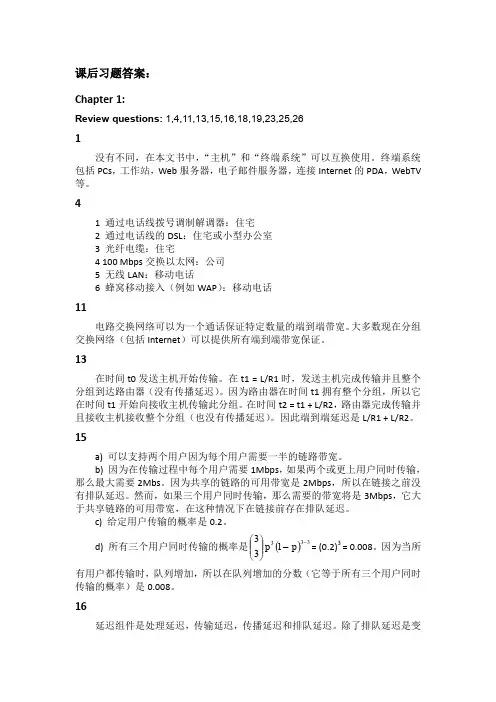
课后习题答案:Chapter 1:Review questions: 1,4,11,13,15,16,18,19,23,25,261没有不同,在本文书中,“主机”和“终端系统”可以互换使用。
终端系统包括PCs ,工作站,Web 服务器,电子邮件服务器,连接Internet 的PDA ,WebTV 等。
41 通过电话线拨号调制解调器:住宅2 通过电话线的DSL :住宅或小型办公室3 光纤电缆:住宅4 100 Mbps 交换以太网:公司5 无线LAN :移动电话6 蜂窝移动接入(例如WAP ):移动电话11电路交换网络可以为一个通话保证特定数量的端到端带宽。
大多数现在分组交换网络(包括Internet )可以提供所有端到端带宽保证。
13在时间t0发送主机开始传输。
在t1 = L/R1时,发送主机完成传输并且整个分组到达路由器(没有传播延迟)。
因为路由器在时间t1拥有整个分组,所以它在时间t1开始向接收主机传输此分组。
在时间t2 = t1 + L/R2,路由器完成传输并且接收主机接收整个分组(也没有传播延迟)。
因此端到端延迟是L/R1 + L/R2。
15a) 可以支持两个用户因为每个用户需要一半的链路带宽。
b) 因为在传输过程中每个用户需要1Mbps ,如果两个或更上用户同时传输,那么最大需要2Mbs 。
因为共享的链路的可用带宽是2Mbps ,所以在链接之前没有排队延迟。
然而,如果三个用户同时传输,那么需要的带宽将是3Mbps ,它大于共享链路的可用带宽,在这种情况下在链接前存在排队延迟。
c) 给定用户传输的概率是0.2。
d) 所有三个用户同时传输的概率是()333133--⎪⎪⎭⎫ ⎝⎛p p = (0.2)3 = 0.008。
因为当所有用户都传输时,队列增加,所以在队列增加的分数(它等于所有三个用户同时传输的概率)是0.008。
16延迟组件是处理延迟,传输延迟,传播延迟和排队延迟。
除了排队延迟是变化的,其它所有延迟都是固定的。
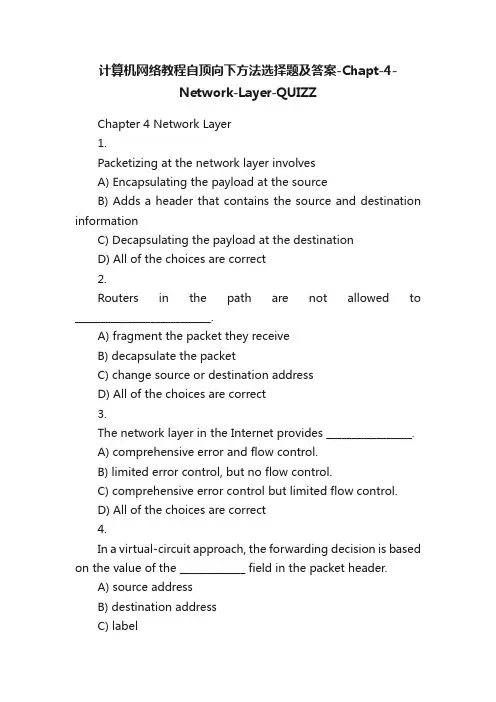
计算机网络教程自顶向下方法选择题及答案-Chapt-4-Network-Layer-QUIZZChapter 4 Network Layer1.Packetizing at the network layer involvesA) Encapsulating the payload at the sourceB) Adds a header that contains the source and destination informationC) Decapsulating the payload at the destinationD) All of the choices are correct2.Routers in the path are not allowed to ___________________________.A) fragment the packet they receiveB) decapsulate the packetC) change source or destination addressD) All of the choices are correct3.The network layer in the Internet provides _________________.A) comprehensive error and flow control.B) limited error control, but no flow control.C) comprehensive error control but limited flow control.D) All of the choices are correct4.In a virtual-circuit approach, the forwarding decision is based on the value of the _____________ field in the packet header.A) source addressB) destination addressC) labelD) None of the choices are correct5.In a datagram approach, the forwarding decision is based on the value of the _____________ field in the packet header.A) source addressB) destination addressC) labelD) None of the choices are correct6.The performance of a network can be measured in terms of ________.A) delayB) throughputC) packet lossD) all of the choices are correct7.Transmission delay (time) is the ratio of ______________________.A) transmission rate to packet lengthB) transmission rate to distanceC) packet length to transmission rateD) processing time to transmission rate8.Propagation delay (time) is the ratio of ______________________.A) transmission rate to propagation speedB) propagation speed to distanceC) packet length to propagation speedD) distance to propagation speed9.When the load in the network reaches the network capacity, the packet delay ___________ and the network throughput reaches______________.A) increases sharply; its minimumB) increases sharply; its maximumC) decreases sharply; its minimumD) decreases sharply; its maximum10.In open-loop congestion control, policies are applied ____________________.A) to prevent congestion before it happensB) to alleviate congestion after it happensC) to either prevent congestion before it happens or to alleviate congestion after it happensD) None of the choices are correct11.The __________________ technique is one of the open-loop congestion policyA) backpressureB) choke packetC) implicit signalingD) None of the choices are correct12.The __________________ technique is one of the close-loop congestion policyA) acknowledgment policyB) choke packetC) discarding policyD) None of the choices are correct13.IP is a _________ protocol.A) connection-oriented unreliableB) connection-oriented reliableC) connectionless unreliableD) connectionless reliable14.An HLEN value of decimal 10 means _______.A) there are 10 bytes of optionsB) there are 10 bytes in the headerC) there are 40 bytes of optionsD) there are 40 bytes in the header15.If the fragment offset has a value of 100, it means that _______.A) the datagram has not been fragmentedB) the datagram is 100 bytes in sizeC) the first byte of the datagram is byte 800D) None of the choices are correct16.What is needed to determine the number of the last byte of a fragment?A) offset numberB) total lengthC) both offset number and the total lengthD) None of the choices are correct17.The IP header size is _______ bytes long.A) 20 to 60B) 20C) 60D) None of the choices are correct18.Packets in the IP layer are called _________.A) segmentsB) datagramsC) framesD) None of the choices are correct19.The total length field defines the total length of the datagram _________.A) including the headerB) excluding the headerC) excluding the option lengthD) None of the choices are correct20.When a datagram is encapsulated in a frame, the total size of the datagram must be less than the _______.A) MUTB) MATC) MTUD) None of the choices are correct21.An IPv4 address is normally represented in base ____ in dotted-decimal notation.A) 16B) 256C) 10D) None of the choices are correct22.In classful addressing, the IPv4 address space is divided into _______ classes.A) 3B) 4D) None of the choices are correct23.The number of addresses assigned to an organization in classless addressing _______.A) can be any numberB) must be a multiple of 256C) must be a power of 2D) None of the choices are correct24.The first address assigned to an organization in classless addressing _______.A) must be evenly divisible by the number of addresses in the organizationB) must be divisible by 128C) must belong to one of the A, B, or C classesD) None of the choices are correct25.In subnetting, the number of addresses in each subnet must _______.A) be a power of 2B) be a multiple of 128C) be divisible by 128D) None of the choices are correct26.What is the default prefix length for class A in CIDR notation?A) 9B) 8C) 16D) None of the choices are correctWhat is the default prefix length for class B in CIDR notation?A) 9B) 8C) 16D) None of the choices are correct28.What is the default prefix length for class C in CIDR notation?A) 24B) 8C) 16D) None of the choices are correct29.DHCP is a (an) ___________ layer protocol.A) applicationB) transportC) networkD) data-link30.In DHCP, the client uses ________ port and the server uses _________ port.A) an ephemeral; a well-knownB) a well-known; a well-knownC) a well-known; an ephemeralD) None of the choices are correct31.DHCP uses the services of _______.A) UDPB) TCPC) IPD) None of the choices are correct32._________ allows a site to use a set of private addresses for internal communication and a set of global Internet addresses for communication with the rest of the world.A) DHCPB) NATC) IMCPD) None of the choices are correct33.The idea of address aggregation was designed to alleviate the increase in routing table entries when using ________ addressing.A) classfulB) classlessC) classful or classlessD) None of the choices are correct34.The use of hierarchy in routing tables can ________ the size of the routing tables.A) reduceB) increaseC) neither reduce nor increaseD) None of the choices are correct35.ICMP is a (an) _________ layer protocol.A) application-layer protocol that helps TCP/IP at the network layerB) transport-layer protocol that helps TCP/IP at the network layerC) network-layer protocol.D) data-link layer protocol that helps TCP/IP at the network layer36.Which of the following is true about ICMP messages?A) An ICMP error message may be generated for an ICMP error message.B) An ICMP error message may be generated for a fragmented datagram.C) An ICMP error message may be generated for a multicast datagram.D) None of the choices are correct37.Routing inside an autonomous system is referred to as ________ routing.A) interdomainB) intradomainC) out-of-domainD) None of the choices are correct38.Routing between autonomous systems is referred to as ______ routing.A) interdomain routingB) intradomain routingC) out-of-domainD) None of the choices are correct39.In _______ routing, the least cost route between any two nodes is the route with the minimum distance.A) path vectorB) distance vectorC) link stateD) None of the choices are correct40.In ________, each node maintains a vector (table) of minimum distances to every node.A) path vectorB) distance vectorC) link stateD) None of the choices are correct41.。
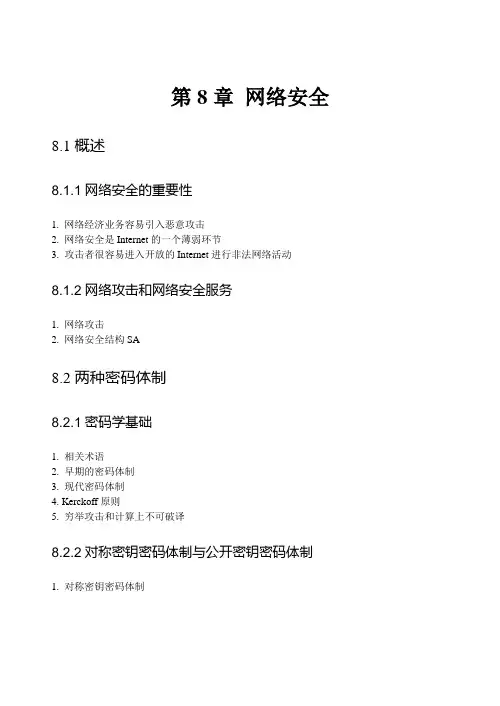
第8章网络安全8.1概述8.1.1网络安全的重要性1. 网络经济业务容易引入恶意攻击2. 网络安全是Internet的一个薄弱环节3. 攻击者很容易进入开放的Internet进行非法网络活动8.1.2网络攻击和网络安全服务1. 网络攻击2. 网络安全结构SA8.2两种密码体制8.2.1密码学基础1. 相关术语2. 早期的密码体制3. 现代密码体制4. Kerckoff原则5. 穷举攻击和计算上不可破译8.2.2对称密钥密码体制与公开密钥密码体制1. 对称密钥密码体制计算机网络(第3版)图8.1对称密钥密码体制2. 公开密钥密码体制图8.2公开密钥密码体制3. 应用场合8.2.3对称密钥密码体制的经典算法DES 1. DES算法计算机网络(第3版)图8.3DES加密算法图8.4初始置换和逆置换图8.5扩展变换E()图8.6S1()计算机网络(第3版)图8.7P()置换图8.8置换2. DES算法的发展图8.9DES-CBC加密解密过程3. 对称密钥密码体制的其他算法计算机网络(第3版)8.2.4公开密钥密码体制的经典算法RSA1. RSA算法2. RSA算法示例3. 实用中的密钥长度8.3数字签名和报文摘要8.3.1数字签名1. 数字签名的特点2. 基于公开密钥算法的数字签名计算机网络(第3版)图8.10采用公开密钥算法的数字签名3. 加密的数字签名8.3.2报文摘要1. 报文摘要产生的背景2. 报文摘要及其特点3. 使用报文摘要的数字签名图8.11使用报文摘要的数字签名4. MD5和SHA-1计算机网络(第3版)8.4身份认证和密钥分发8.4.1概述1. 身份认证2. 密钥分发8.4.2基于对称密钥的身份认证和密钥分发1. 密钥分发与密钥分发中心2. 基于对称密钥的身份认证和密钥分发机制图8.12基于KDC的身份认证和密钥分发3. 一次性随机数和会话密钥8.4.3基于公钥的身份认证和公钥分发1. 基于公钥的认证2. 公钥分发图8.13X.509版本3公钥证书结构计算机网络(第3版)8.5Internet网络安全技术8.5.1网际层安全技术1. 安全协议AH和ESP图8.14AH和ESP格式图8.15传输模式中的AH和ESP计算机网络(第3版)图8.16隧道模式中的AH和ESP2. 安全关联(SA)3. 因特网密钥交换(IKE)8.5.2传输层安全技术图8.17TLS记录协议的操作过程8.5.3应用层安全技术1. 安全电子邮件计算机网络(第3版)图8.18PGP加密过程2. WWW安全标准3. 通用安全服务API8.6防火墙8.6.1概述8.6.2防火墙技术1. 包过滤技术2. 代理服务技术3. 防火墙技术示例图8.19防火墙的例子8.6.3防火墙系统1. 防火墙系统的结构2. 包过滤防火墙3. 双穴主机网关防火墙图8.20包过滤防火墙图8.21双穴主机网关防火墙4. 屏蔽主机网关防火墙图8.22屏蔽主机网关防火墙5. 屏蔽子网防火墙图8.23屏蔽子网防火墙8.7虚拟专用网(VPN)8.7.1概述1. 什么是VPN2. VPN类型8.7.2VPN隧道和隧道协议1. VPN隧道2. 隧道技术涉及的协议种类3. 隧道协议8.7.3L2TP VPN1. L2TP隧道2. L2TP报文及其格式3. L2TP VPN的数据封装与传输图8.26Internet上的L2TP数据传输8.7.4IPSec VPN1. 内联网IPSec VPN和外联网IPSec VPN图8.27LAN-to-LAN IPSec VPN 2. 远程访问IPSec VPN图8.28远程访问IPSec VPN思考题8.1网络攻击主要有哪几种方式?网络安全服务主要涉及哪些方面?8.2什么是密码技术中的Kerckoff原则?为什么会有这样的原则?8.3什么样的密钥可以做到计算上不可破译?试举一例说明。
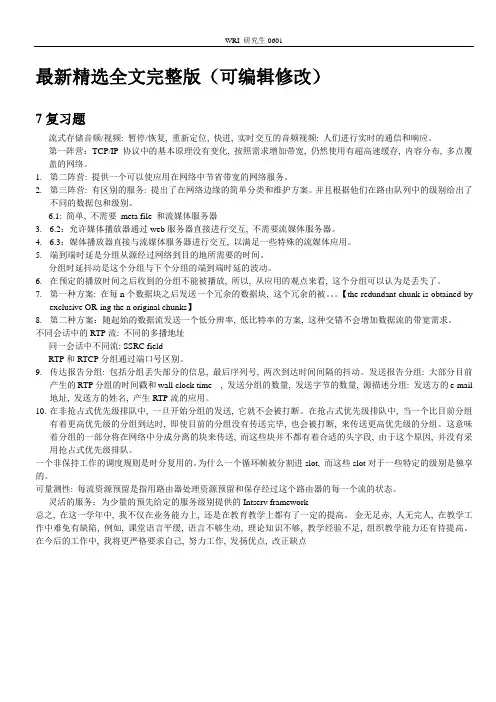
WRI 研究生0601最新精选全文完整版(可编辑修改)7复习题流式存储音频/视频: 暂停/恢复, 重新定位, 快进, 实时交互的音频视频: 人们进行实时的通信和响应。
第一阵营:TCP/IP协议中的基本原理没有变化, 按照需求增加带宽, 仍然使用有超高速缓存, 内容分布, 多点覆盖的网络。
1.第二阵营: 提供一个可以使应用在网络中节省带宽的网络服务。
2.第三阵营: 有区别的服务: 提出了在网络边缘的简单分类和维护方案。
并且根据他们在路由队列中的级别给出了不同的数据包和级别。
6.1: 简单, 不需要meta file 和流媒体服务器3. 6.2:允许媒体播放器通过web服务器直接进行交互, 不需要流媒体服务器。
4. 6.3:媒体播放器直接与流媒体服务器进行交互, 以满足一些特殊的流媒体应用。
5.端到端时延是分组从源经过网络到目的地所需要的时间。
分组时延抖动是这个分组与下个分组的端到端时延的波动。
6.在预定的播放时间之后收到的分组不能被播放, 所以, 从应用的观点来看, 这个分组可以认为是丢失了。
7.第一种方案: 在每n个数据块之后发送一个冗余的数据块, 这个冗余的被。
【the redundant chunk is obtained byexclusive OR-ing the n original chunks】8.第二种方案:随起始的数据流发送一个低分辨率, 低比特率的方案, 这种交错不会增加数据流的带宽需求。
不同会话中的RTP流: 不同的多播地址同一会话中不同流: SSRC fieldRTP和RTCP分组通过端口号区别。
9.传达报告分组: 包括分组丢失部分的信息, 最后序列号, 两次到达时间间隔的抖动。
发送报告分组: 大部分目前产生的RTP分组的时间戳和wall clock time , 发送分组的数量, 发送字节的数量, 源描述分组: 发送方的e-mail 地址, 发送方的姓名, 产生RTP流的应用。
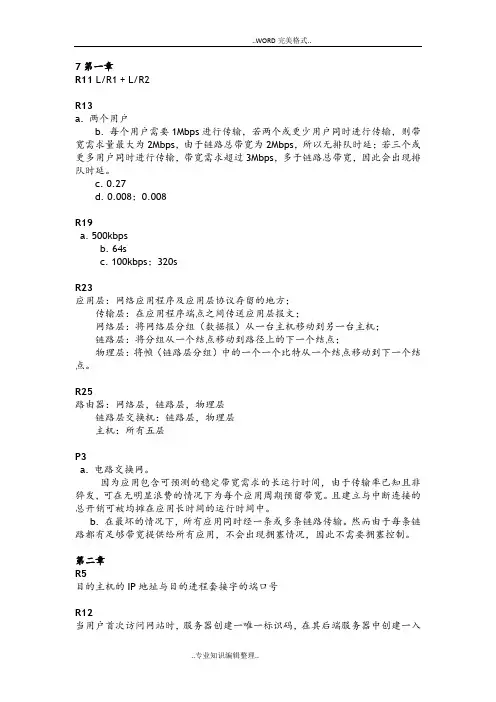
7第一章R11 L/R1 + L/R2R13a. 两个用户b. 每个用户需要1Mbps进行传输,若两个或更少用户同时进行传输,则带宽需求量最大为2Mbps,由于链路总带宽为2Mbps,所以无排队时延;若三个或更多用户同时进行传输,带宽需求超过3Mbps,多于链路总带宽,因此会出现排队时延。
c. 0.27d. 0.008;0.008R19a. 500kbpsb. 64sc. 100kbps;320sR23应用层:网络应用程序及应用层协议存留的地方;传输层:在应用程序端点之间传送应用层报文;网络层:将网络层分组(数据报)从一台主机移动到另一台主机;链路层:将分组从一个结点移动到路径上的下一个结点;物理层:将帧(链路层分组)中的一个一个比特从一个结点移动到下一个结点。
R25路由器:网络层,链路层,物理层链路层交换机:链路层,物理层主机:所有五层P3a. 电路交换网。
因为应用包含可预测的稳定带宽需求的长运行时间,由于传输率已知且非猝发,可在无明显浪费的情况下为每个应用周期预留带宽。
且建立与中断连接的总开销可被均摊在应用长时间的运行时间中。
b. 在最坏的情况下,所有应用同时经一条或多条链路传输。
然而由于每条链路都有足够带宽提供给所有应用,不会出现拥塞情况,因此不需要拥塞控制。
第二章R5目的主机的IP地址与目的进程套接字的端口号R12当用户首次访问网站时,服务器创建一唯一标识码,在其后端服务器中创建一入口,将该唯一标识码作为Cookie 码返回,该cookie 码储存在用户主机中,由浏览器管理。
在后来每次的访问与购买中,浏览器将cookie 码发送给网站,因此当该用户(准确地说,该浏览器)访问该网站时,网站会立即获知。
R15FTP 使用两平行TCP 连接,一条连接发送控制信息(例如文件传输请求),另一条连接用作实际传输文件。
由于控制信息不会通过与文件传输相同的连接发送,因此FTP 在“带外”发送控制信息。
R19是的,一个机构的邮件服务器和Web 服务器可以有完全相同的主机名别名。
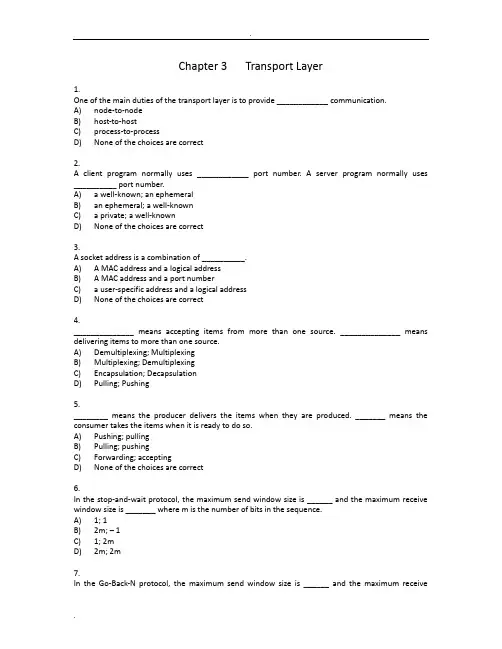
Chapter 3 Transport Layer1.One of the main duties of the transport layer is to provide ____________ communication.A) node-to-nodeB) host-to-hostC) process-to-processD) None of the choices are correct2.A client program normally uses ____________ port number. A server program normally uses __________ port number.A) a well-known; an ephemeralB) an ephemeral; a well-knownC) a private; a well-knownD) None of the choices are correct3.A socket address is a combination of __________.A) A MAC address and a logical addressB) A MAC address and a port numberC) a user-specific address and a logical addressD) None of the choices are correct4.______________ means accepting items from more than one source. ______________ means delivering items to more than one source.A) Demultiplexing; MultiplexingB) Multiplexing; DemultiplexingC) Encapsulation; DecapsulationD) Pulling; Pushing5.________ means the producer delivers the items when they are produced. _______ means the consumer takes the items when it is ready to do so.A) Pushing; pullingB) Pulling; pushingC) Forwarding; acceptingD) None of the choices are correct6.In the stop-and-wait protocol, the maximum send window size is ______ and the maximum receive window size is _______ where m is the number of bits in the sequence.A) 1; 1B) 2m; – 1C) 1; 2mD) 2m; 2m7.In the Go-Back-N protocol, the maximum send window size is ______ and the maximum receivewindow size is _______, where m is related to the number of bits in the sequence. number.A) 1; 1B) 1; 2mC) 2m – 1; 1D) 2m – 1; 2m – 18.In the selective-repeat protocol, the maximum send window size is ______ and the maximum receive window size is _______, where m is the number of bits in the sequence.A) 1; 1B) 1; 2m – 1C) 2m – 1; 1D) 2m – 1; 2m – 19.UDP is a ________________ transport protocol.A) connectionless, reliableB) connection-oriented, unreliableC) connectionless, unreliableD) None of the choices are correct10.UDP is an acronym for _______.A) User Delivery ProtocolB) User Datagram ProcedureC) User Datagram ProtocolD) None of the choices are correct11.At the transport layer, to define the processes, we need two identifiers called ____________.A) logical addressesB) physical addressesC) port addressesD) None of the choices are correct12.The ports ranging from 0 to 1,023 are called the ___________ ports. The ports ranging from 1,024 to 49,151 are called ___________ ports. The ports ranging from 49,152 to 65,535 are called the ___________ ports.A) well-known; registered; dynamic or privateB) registered; dynamic or private; well-knownC) private or dynamic; well-known; registeredD) private or dynamic; registered; well-known13.UDP and TCP are two protocols at the ___________ layer.A) data linkB) networkC) transportD) application14.Which of the following functions are performed by UDP?A) process-to-process communicationB) host-to-host communicationC) node-to-node communicationD) None of the choices are correct15.A port number is _______ bits long.A) 8B) 16C) 32D) 6416.Which of the following does UDP provide?A) flow controlB) connection-oriented deliveryC) error controlD) None of the choices are correct17.The source port number on the UDP user datagram header defines _______.A) the sending computerB) the receiving computerC) the process running on the sending computerD) None of the choices are correct18.To use the services of UDP, we need ________ socket addresses.A) fourB) twoC) threeD) None of the choices are correct19.UDP packets are called __________ .A) user datagramsB) segmentsC) framesD) None of the choices are correct20.UDP packets have a fixed-size header of _______ bytes.A) 16B) 8C) 40D) 3221.TCP is a __________ protocol.A) byte-orientedB) message-orientedC) block-orientedD) None of the choices are correct22.TCP groups a number of bytes together into a packet called a ___________.A) user datagramB) segmentC) datagramD) None of the choices are correct23.TCP is a(n) ___________ protocol.A) connection-orientedB) connectionlessC) both connection-oriented and connectionlessD) None of the choices are correct24.TCP is a(n) _______ transport protocol.A) unreliableB) best-effort deliveryC) reliableD) None of the choices are correct25.TCP uses _________________ to check the safe and sound arrival of data.A) an acknowledgment mechanismB) out-of-band signalingC) the services of another protocolD) None of the choices are correct26.The bytes of data being transferred in each connection are numbered by TCP. The numbering starts with a __________________.A) 0B) 1C) randomly generated numberD) None of the choices are correct27.In TCP, the sequence number for each segment is the number of the _______ byte (virtual byte) carried in that segment.A) firstB) lastC) middleD) None of the choices are correct28.Communication in TCP is ___________.A) simplexB) half-duplexC) full-duplexD) None of the choices are correct29.In TCP, the value of the acknowledgment field in a sent segment defines the sequence number related to the ______ byte a party expects to receive next.A) firstB) lastC) nextD) None of the choices are correct30.The inclusion of the checksum in the TCP segment is ________.A) optionalB) mandatoryC) depends on the type of dataD) None of the choices are correct31.In TCP, a SYN segment consumes _____ sequence number(s).A) noB) oneC) twoD) None of the choices are correct32.In TCP, a SYN + ACK segment consumes _____ sequence numbers.A) noB) threeC) twoD) one33.In TCP, an ACK segment, if carrying no data, consumes ______ sequence number(s).A) noB) oneC) twoD) None of the choices are correct34.The connection establishment procedure in TCP is susceptible to a serious security problem called the _________ attack.A) ACK floodingB) FIN floodingC) SYN floodingD) None of the choices are correct35.The SYN flooding attack belongs to a group of security attacks known as a _____ attack.A) denial of serviceB) replayC) man-in-the middleD) None of the choices are correct36.In TCP, a FIN segment consumes ____ sequence numbers if it does not carry data.A) twoB) threeC) noD) one37.In TCP, a FIN + ACK segment consumes _____ sequence number(s) if it does not carry data.A) twoB) threeC) oneD) no38.In TCP, one end can stop sending data while still receiving data. This is called a ______ termination.A) half-closeB) half-openC) full-closeD) None of the choices are correct39.TCP sliding windows are __________ oriented.A) packetB) segmentC) byteD) None of the choices are correct40.In TCP, the size of the send window is the ________ of rwnd and cwnd.A) maximumB) sum ofC) minimumD) None of the choices are correct41.In TCP, the window should not be _________.A) openedB) closedC) shrunkD) slide42.In TCP, the receiver can temporarily shut down the window; the sender, however, can always send a segment of _____ byte(s) after the window is shut down.A) tenB) zeroC) oneD) None of the choices are correct43.A serious problem can arise in the sliding window operation when either the sending application program creates data slowly or the receiving application program consumes data slowly, or both. This problem is called the ______.A) silly window syndromeB) unexpected syndromeC) window bugD) None of the choices are correct44.Nagle's algorithm can solve the silly window syndrome created by the _________.A) senderB) receiverC) both sender and receiverD) None of the choices are correct45.Clark's solution can solve the silly window syndrome created by the _________.A) senderB) receiverC) both sender and receiverD) None of the choices are correct46.Delayed acknowledgment can solve the silly window syndrome created by the _________.A) senderB) receiverC) both sender and receiverD) None of the choices are correct47.In TCP, an ACK segments that carry no data consumes _______ sequence number(s).A) noB) oneC) twoD) None of the choices are correct48.In modern implementations of TCP, a retransmission occurs if the retransmission timer expires or ________ duplicate ACK segments have arrived.A) oneB) twoC) threeD) None of the choices are correct49.In TCP, ________ retransmission timer is set for an ACK segment.A) oneB) a previousC) noD) None of the choices are correct50.In TCP, there can be ______ RTT measurement(s) in progress at any time.A) twoB) only oneC) severalD) None of the choices are correct51.We need to multiply the header length field by _______ to find the total number of bytes in the TCP header.A) 2B) 4C) 6D) None of the choices are correct52.In TCP, urgent data requires the urgent pointer field as well as the URG bit (to be set) in the _______ field.A) controlB) offsetC) sequence numberD) None of the choices are correct53.In TCP, if the ACK value is 200, then byte _______ has been received successfully.A) 199B) 200C) 201D) None of the choices are correct54.In TCP, the _______ timer prevents a long idle connection between two TCPs.A) retransmissionB) persistenceC) keepaliveD) None of the choices are correct55.In TCP, the _______ timer is needed to handle the zero window-size advertisement.A) retransmissionB) persistenceC) keepaliveD) None of the choices are correct56.In TCP, Karn's algorithm is used in calculations by the _______ timer.A) retransmissionB) persistenceC) keepaliveD) None of the choices are correct57.In TCP, a special segment called a probe is sent by a sending TCP when the _______ timer goes off.A) transmissionB) persistenceC) keepaliveD) None of the choices are correct58.__________ control refers to the mechanisms and techniques to keep the load below the capacity.A) flowB) errorC) congestionD) None of the choices are correct59.In TCP's ________ algorithm the size of the congestion window increases exponentially until it reaches a threshold.A) congestion avoidanceB) congestion detectionC) slow startD) None of the choices are correct60.In TCP's __________ algorithm the size of the congestion window increases additively until congestion is detected.A) congestion avoidanceB) congestion detectionC) slow startD) None of the choices are correct61.________ treats the two signs of congestion detections, timeout and three duplicate ACKs, in the same way.A) Taho TCPB) Reno TCPC) new Reno TCPD) None of the choices are correct62.In ______ TCP, when the connection is established, TCP starts the slow start algorithms and sets the ssthresh variable to a pre-agreed value (normally 64 or 128 kilobytes) and the cwnd variable to 1 MSS.A) Taho TCPB) Reno TCPC) new Reno TCPD) None of the choices are correct63.The ___________ added a new state to the congestion control FSM, called the fast recovery state.A) Taho TCPB) Reno TCPC) new Reno TCPD) None of the choices are correct64.The ___________ treated the two signals of congestion, timeout and arrival of three duplicate ACKs, differently.A) Taho TCPB) Reno TCPC) new Reno TCPD) None of the choices are correct65.The __________ state in Reno TCP is a state somehow between the slow start and the congestion avoidance states.A) congestion avoidanceB) congestion detectionC) slow recoveryD) None of the choices are correct66.In the Reno TCP, when TCP enters the fast recovery, if duplicate ACKs continue to come, TCP ____________________________________.A) stays in this state, but the cwnd grows additivelyB) stays in this state, but the cwnd grows exponentiallyC) moves to slow start stateD) moves to the congestion avoidance state but deflate the size of the cwnd to ssthresh value67.In the Reno TCP, when TCP enters the fast recovery, if a timeout occurs, TCP ____________________________________.A) stays in this state, but the cwnd grows additivelyB) stays in this state, but the cwnd grows exponentiallyC) moves to slow start stateD) moves to the congestion avoidance state but deflate the size of the cwnd to ssthresh value68.In the Reno TCP, when TCP enters the fast recovery, if a new (non duplicate) ACK arrives TCP.____________________________________.A) stays in this state, but the cwnd grows additivelyB) stays in this state, but the cwnd grows exponentiallyC) moves to slow start stateD) moves to the congestion avoidance state but deflate the size of the cwnd to ssthresh value69.A later version of TCP, called ______ TCP, made an extra optimization on the _______ TCP.A) New Reno; RenoB) New Taho; TahoC) New Reno; TahoD) New Taho; Reno70.In the slow start algorithm, the size of the congestion window grows ______________ until ___________________.A) exponentially; it reaches a thresholdB) exponentially; congestion is detectedC) additively; it reaches a thresholdD) additively; congestion is detected71.In the congestion avoidance algorithm, the size of the congestion window grows ______________ congestion is detected.A) exponentially; it reaches a thresholdB) exponentially; congestion is detectedC) additively; it reaches a thresholdD) additively; congestion is detected72.The congestion window size, after it passes the initial slow start state, follows a saw tooth pattern called _________________________________.A) exponential increase, additive decreaseB) additive increase, exponential decreaseC) multiplicative increase, additive decreaseD) additive increase, multiplicative decreaseCBDBA ACDCC CACAB DCBAB ABACA CACCB BDACA DCACC CCAAB BACCB BAACB ABCCA AABBD BCDAA DD.。

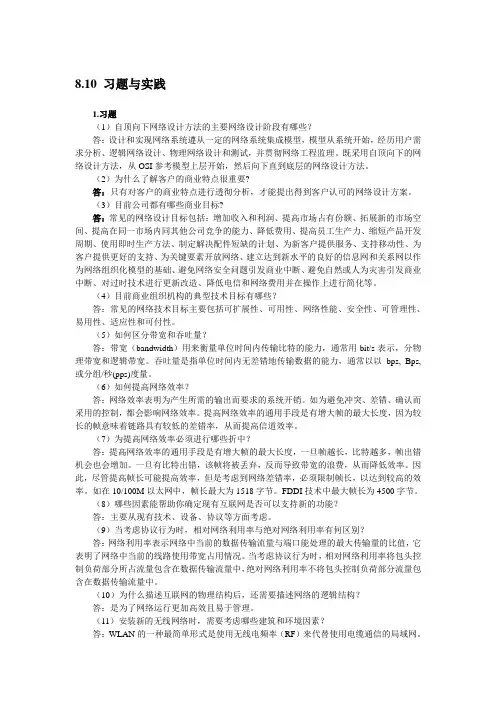
8.10 习题与实践1.习题(1)自顶向下网络设计方法的主要网络设计阶段有哪些?答:设计和实现网络系统遵从一定的网络系统集成模型,模型从系统开始,经历用户需求分析、逻辑网络设计、物理网络设计和测试,并贯彻网络工程监理。
既采用自顶向下的网络设计方法,从OSI参考模型上层开始,然后向下直到底层的网络设计方法。
(2)为什么了解客户的商业特点很重要?答:只有对客户的商业特点进行透彻分析,才能提出得到客户认可的网络设计方案。
(3)目前公司都有哪些商业目标?答:常见的网络设计目标包括:增加收入和利润、提高市场占有份额、拓展新的市场空间、提高在同一市场内同其他公司竞争的能力、降低费用、提高员工生产力、缩短产品开发周期、使用即时生产方法、制定解决配件短缺的计划、为新客户提供服务、支持移动性、为客户提供更好的支持、为关键要素开放网络、建立达到新水平的良好的信息网和关系网以作为网络组织化模型的基础、避免网络安全问题引发商业中断、避免自然或人为灾害引发商业中断、对过时技术进行更新改造、降低电信和网络费用并在操作上进行简化等。
(4)目前商业组织机构的典型技术目标有哪些?答:常见的网络技术目标主要包括可扩展性、可用性、网络性能、安全性、可管理性、易用性、适应性和可付性。
(5)如何区分带宽和吞吐量?答:带宽(bandwidth)用来衡量单位时间内传输比特的能力,通常用bit/s表示,分物理带宽和逻辑带宽。
吞吐量是指单位时间内无差错地传输数据的能力,通常以以bps, Bps,或分组/秒(pps)度量。
(6)如何提高网络效率?答:网络效率表明为产生所需的输出而要求的系统开销。
如为避免冲突、差错、确认而采用的控制,都会影响网络效率。
提高网络效率的通用手段是有增大帧的最大长度,因为较长的帧意味着链路具有较低的差错率,从而提高信道效率。
(7)为提高网络效率必须进行哪些折中?答:提高网络效率的通用手段是有增大帧的最大长度,一旦帧越长,比特越多,帧出错机会也会增加。
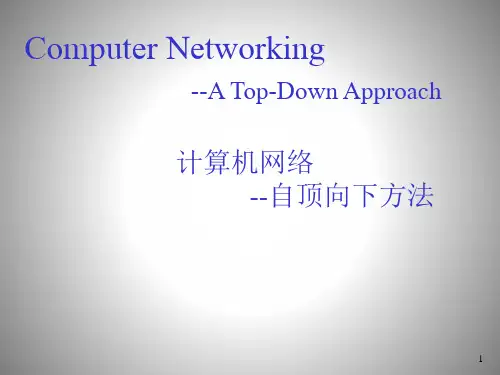
课后习题答案:Chapter 1:Review questions: 1,4,11,13,15,16,18,19,23,25,261没有不同,在本文书中,“主机”和“终端系统”可以互换使用。
终端系统包括PCs ,工作站,Web 服务器,电子邮件服务器,连接Internet 的PDA ,WebTV 等。
41 通过电话线拨号调制解调器:住宅2 通过电话线的DSL :住宅或小型办公室3 光纤电缆:住宅4 100 Mbps 交换以太网:公司5 无线LAN :移动电话6 蜂窝移动接入(例如WAP ):移动电话11电路交换网络可以为一个通话保证特定数量的端到端带宽。
大多数现在分组交换网络(包括Internet )可以提供所有端到端带宽保证。
13在时间t0发送主机开始传输。
在t1 = L/R1时,发送主机完成传输并且整个分组到达路由器(没有传播延迟)。
因为路由器在时间t1拥有整个分组,所以它在时间t1开始向接收主机传输此分组。
在时间t2 = t1 + L/R2,路由器完成传输并且接收主机接收整个分组(也没有传播延迟)。
因此端到端延迟是L/R1 + L/R2。
15a) 可以支持两个用户因为每个用户需要一半的链路带宽。
b) 因为在传输过程中每个用户需要1Mbps ,如果两个或更上用户同时传输,那么最大需要2Mbs 。
因为共享的链路的可用带宽是2Mbps ,所以在链接之前没有排队延迟。
然而,如果三个用户同时传输,那么需要的带宽将是3Mbps ,它大于共享链路的可用带宽,在这种情况下在链接前存在排队延迟。
c) 给定用户传输的概率是0.2。
d) 所有三个用户同时传输的概率是()333133--⎪⎪⎭⎫ ⎝⎛p p = (0.2)3 = 0.008。
因为当所有用户都传输时,队列增加,所以在队列增加的分数(它等于所有三个用户同时传输的概率)是0.008。
16延迟组件是处理延迟,传输延迟,传播延迟和排队延迟。
除了排队延迟是变化的,其它所有延迟都是固定的。
1.端系统和网络核心,协议处在因特网边缘的部分就是连接在因特网上的全部的主机.这些主机又称为蟠系统(Cndsystem)网络核心部分要向网络边缘中的大量主机供应连通性,使边缘部分中的任何一个主机都能够向其他主机通信(即传送或接收各种形式的数据)・在网络核心部分起特别作用的是路由器(router)。
路由器是实现分组交换(PaCketSWitChing)的关键构件,其任务是转发收到的分组,这是网络核心部分最重要的功能。
注:分组交换主要有两类,一类叫做路由器,一类叫作桂路层交换机两者的作用类似,都是转发分组,不同点在于转发分组所依据的信息不同。
路由器依据分组中的IP地址转发分组,链路层交换机依据分组中的目的MAC地址转发分组。
用于网络核心的交换技术主要有两种:电路交换(CirCUitswitching),分组交换(PaCketswitching)协议(ProtOco1)是通信双方共同遵守的规则,主要用于指定分组格式以及接收到每个分组后执行的动作。
2.两种基本的服务(1)面对连接的服务保证从发送端发送到接收端的数据最终将按依次,完整地到达接收端面对连接服务的过程包括连接建立,数据传输和连接释放3个阶段。
在数据交换之前,必需先建立连接;数据交换结束后,必需终止这个连接。
传送数据时是按序传送的。
有握手信号,由tcp供应,供应牢靠的流量限制和拥塞限制(2)无连接服务对于传输不供应任何保证在无连接服务的状况下,两个实体之间的通信不须要先建立好一个连接,因此其下层的有关资源不须要事先进行预定保留。
这些资源将在数据传输时动态地进行安排。
无连接服务的特点是无握手信号,由UdP供应,不供应牢靠的流量限制和拥塞限制’因而是一种不牢靠的服务,称为“尽最大努力交付二面对连接服务并不等同于牢靠的服务,面对连接服务时牢靠服务的一个必要条件,但不充分,还要加上一些措施才能实现牢靠服务。
目前IntenICt只供应一种服务模型,“尽力而为“,无服务质量功能3.复用技术概念:是指能在同一传输媒质中同时传输多路信号的技术,目的提高通信线路的利用率频分复用(FDM)的全部用户在同样的时间占用不同的带宽资源。
计算机⽹络⾃顶向下第七版第七章答案Computer Networking: A Top-Down Approach,7th Edition计算机⽹络⾃顶向下第七版Solutions to Review Questions and ProblemsChapter 7 Review Questions1.In infrastructure mode of operation, each wireless host is connected to the largernetwork via a base station (access point). If not operating in infrastructure mode, a network operates in ad-hoc mode. In ad-hoc mode, wireless hosts have noinfrastructure with which to connect. In the absence of such infrastructure, the hosts themselves must provide for services such as routing, address assignment, DNS-like name translation, and more.2.a) Single hop, infrastructure-basedb) Single hop, infrastructure-lessc) Multi-hop, infrastructure-basedd) Multi-hop, infrastructure-less3.Path loss is due to the attenuation of the electromagnetic signal when it travelsthrough matter. Multipath propagation results in blurring of the received signal at the receiver and occurs when portions of the electromagnetic wave reflect off objects and ground, taking paths of different lengths between a sender and receiver. Interference from other sources occurs when the other source is also transmitting in the samefrequency range as the wireless network.4.a) Increasing the transmission powerb) Reducing the transmission rate5.APs transmit beacon frames. An AP’s beacon frames will be transmitted over one ofthe 11 channels. The beacon frames permit nearby wireless stations to discover and identify the AP.6.False7.APs transmit beacon frames. An AP’s beacon frames will be transmitted over one ofthe 11 channels. The beacon frames permit nearby wireless stations to discover and identify the AP.8.False9.Each wireless station can set an RTS threshold such that the RTS/CTS sequence isused only when the data frame to be transmitted is longer than the threshold. This ensures that RTS/CTS mechanism is used only for large frames.10.No, there wouldn’t be any advantage. Suppose there are two stations that want totransmit at the same time, and they both use RTS/CTS. If the RTS frame is as long asa DATA frames, the channel would be wasted for as long as it would have beenwasted for two colliding DATA frames. Thus, the RTS/CTS exchange is only useful when the RTS/CTS frames are significantly smaller than the DATA frames.11.Initially the switch has an entry in its forwarding table which associates the wirelessstation with the earlier AP. When the wireless station associates with the new AP, the new AP creates a frame with the wireless station’s MAC address and broadcasts the frame. The frame is received by the switch. This forces the switch to update itsforwarding table, so that frames destined to the wireless station are sent via the new AP.12.Any ordinary Bluetooth node can be a master node whereas access points in 802.11networks are special devices (normal wireless devices like laptops cannot be used as access points).13.False14.“Opportunistic Scheduling” refers to matching the physical layer protocol to channelconditions between the sender and the receiver, and choosing the receivers to which packets will be sent based on channel condition. This allows the base station to make best use of the wireless medium.15.UMTS to GSM and CDMA-2000 to IS-95.16.The data plane role of eNodeB is to forward datagram between UE (over the LTEradio access network) and the P-GW. Its control plane role is to handle registration and mobility signaling traffic on behalf of the UE.The mobility management entity (MME) performs connection and mobility management on behalf of the UEs resident in the cell it controls. It receives UE subscription information from the HHS.The Packet Data Network Gateway (P-GW) allocates IP addresses to the UEs and performs QoS enforcement. As a tunnel endpoint it also performs datagram encapsulation/decapsulation when forwarding a datagram to/from a UE.The Serving Gateway (S-GW) is the data-plane mobility anchor point as all UE traffic will pass through the S-GW. The S-GW also performs charging/billing functions and lawful traffic interception.17.In 3G architecture, there are separate network components and paths for voice anddata, i.e., voice goes through public telephone network, whereas data goes through public Internet. 4G architecture is a unified, all-IP network architecture, i.e., both voice and data are carried in IP datagrams to/from the wireless device to several gateways and then to the rest of the Internet.The 4G network architecture clearly separates data and control plane, which is different from the 3G architecture.The 4G architecture has an enhanced radio access network (E-UTRAN) that is different from 3G’s radio access network UTRAN.18.No. A node can remain connected to the same access point throughout its connectionto the Internet (hence, not be mobile). A mobile node is the one that changes its point of attachment into the network over time. Since the user is always accessing theInternet through the same access point, she is not mobile.19.A permanent address for a mobile node is its IP address when it is at its homenetwork. A care-of-address is the one its gets when it is visiting a foreign network.The COA is assigned by the foreign agent (which can be the edge router in theforeign network or the mobile node itself).20.False21.The home network in GSM maintains a database called the home location register(HLR), which contains the permanent cell phone number and subscriber profileinformation about each of its subscribers. The HLR also contains information about the current locations of these subscribers. The visited network maintains a database known as the visitor location register (VLR) that contains an entry for each mobile user that is currently in the portion of the network served by the VLR. VLR entries thus come and go as mobile users enter and leave the network.The edge router in home network in mobile IP is similar to the HLR in GSM and the edge router in foreign network is similar to the VLR in GSM.22.Anchor MSC is the MSC visited by the mobile when a call first begins; anchor MSCthus remains unchanged during the call. Throughout the call’s duration and regardless of the number of inter-MSC transfers performed by the mobile, the call is routed from the home MSC to the anchor MSC, and then from the anchor MSC to the visited MSC where the mobile is currently located.23.a) Local recoveryb) TCP sender awareness of wireless linksc) Split-connection approachesChapter 7 ProblemsProblem 1Output corresponding to bit d 1 = [-1,1,-1,1,-1,1,-1,1]Output corresponding to bit d 0 = [1,-1,1,-1,1,-1,1,-1]Problem 2Sender 2 output = [1,-1,1,1,1,-1,1,1]; [ 1,-1,1,1,1,-1,1,1]Problem 3181111)1()1(111111)1()1(1112=?+?+-?-+?+?+?+-?-+?=d 181111)1()1(111111)1()1(1122=?+?+-?-+?+?+?+-?-+?=dProblem 4Sender 1: (1, 1, 1, -1, 1, -1, -1, -1)Sender 2: (1, -1, 1, 1, 1, 1, 1, 1)Problem 5a) The two APs will typically have different SSIDs and MAC addresses. A wirelessstation arriving to the café will associate with one of the SSIDs (that is, one of the APs). After association, there is a virtual link between the new station and the AP. Label the APs AP1 and AP2. Suppose the new station associates with AP1. When the new station sends a frame, it will be addressed to AP1. Although AP2 will alsoreceive the frame, it will not process the frame because the frame is not addressed to it. Thus, the two ISPs can work in parallel over the same channel. However, the two ISPs will be sharing the same wireless bandwidth. If wireless stations in different ISPs transmit at the same time, there will be a collision. For 802.11b, the maximum aggregate transmission rate for the two ISPs is 11 Mbps.b) Now if two wireless stations in different ISPs (and hence different channels) transmitat the same time, there will not be a collision. Thus, the maximum aggregatetransmission rate for the two ISPs is 22 Mbps for 802.11b.Problem 6Suppose that wireless station H1 has 1000 long frames to transmit. (H1 may be an AP that is forwarding an MP3 to some other wireless station.) Suppose initially H1 is the onlystation that wants to transmit, but that while half-way through transmitting its first frame, H2 wants to transmit a frame. For simplicity, also suppose every station can hear every other station’s signal (that is, no hidden terminals). Before transmitting, H2 will sense that the channel is busy, and therefore choose a random backoff value.Now suppose that after sending its first frame, H1 returns to step 1; that is, it waits a short period of times (DIFS) and then starts to transmit the second frame. H1’s second frame will then be transmitted while H2 is stuck in backoff, waiting for an idle channel. Thus, H1 should get to transmit all of its 1000 frames before H2 has a chance to access the channel. On the other hand, if H1 goes to step 2 after transmitting a frame, then it too chooses a random backoff value, thereby giving a fair chance to H2. Thus, fairness was the rationale behind this design choice.Problem 7A frame without data is 32 bytes long. Assuming a transmission rate of 11 Mbps, the time to transmit a control frame (such as an RTS frame, a CTS frame, or an ACK frame) is (256 bits)/(11 Mbps) = 23 usec. The time required to transmit the data frame is (8256 bits)/(11 Mbps) = 751DIFS + RTS + SIFS + CTS + SIFS + FRAME + SIFS + ACK= DIFS + 3SIFS + (3*23 + 751) usec = DIFS + 3SIFS + 820 usecProblem 8a) 1 message/ 2 slotsb) 2 messages/slotc) 1 message/slota)i) 1 message/slotii) 2 messages/slotiii) 2 messages/slotb)i) 1 message/4 slotsii) slot 1: Message A→ B, message D→ Cslot 2: Ack B→ Aslot 3: Ack C→ D= 2 messages/ 3 slotsiii)slot 1: Message C→ Dslot 2: Ack D→C, message A→ BRepeatslot 3: Ack B→ A= 2 messages/3 slotsProblem 10a)10 Mbps if it only transmits to node A. This solution is not fair since only A is gettingserved. By “fair” it m eans that each of the four nodes should be allotted equal number of slots.b)For the fairness requirement such that each node receives an equal amount of dataduring each downstream sub-frame, let n1, n2, n3, and n4 respectively represent the number of slots that A, B, C and D get. Now,data transmitted to A in 1 slot = 10t Mbits(assuming the duration of each slot to be t)Hence,Total amount of data transmitted to A (in n1 slots) = 10t n1Similarly total amounts of data transmitted to B, C, and D equal to 5t n2, 2.5t n3, and t n4 respectively.Now, to fulfill the given fairness requirement, we have the following condition:10t n1 = 5t n2 = 2.5t n3 = t n4Hence,n2 = 2 n1n3 = 4 n1n4 = 10 n1Now, the total number of slots is N. Hence,n1+ n2+ n3+ n4 = Ni.e. n1+ 2 n1 + 4 n1 + 10 n1 = Ni.e. n1 = N/17Hence,n2 = 2N/17n3 = 4N/17n4 = 10N/17The average transmission rate is given by:(10t n1+5t n2+ 2.5t n3+t n4)/tN= (10N/17 + 5 * 2N/17 + 2.5 * 4N/17 + 1 * 10N/17)/N= 40/17 = 2.35 Mbpsc)Let node A receives twice as much data as nodes B, C, and D during the sub-frame.Hence,10tn1 = 2 * 5tn2 = 2 * 2.5tn3 = 2 * tn4i.e. n2 = n1n3 = 2n1n4 = 5n1Again,n1 + n2 + n3 + n4 = Ni.e. n 1+ n1 + 2n1 + 5n1 = Ni.e. n1 = N/9Now, average transmission rate is given by:(10t n1+5t n2+ 2.5t n3+t n4)/tN= 25/9 = 2.78 MbpsSimilarly, considering nodes B, C, or D receive twice as much data as any other nodes, different values for the average transmission rate can be calculated.Problem 11a)No. All the routers might not be able to route the datagram immediately. This isbecause the Distance Vector algorithm (as well as the inter-AS routing protocols like BGP) is decentralized and takes some time to terminate. So, during the time when the algorithm is still running as a result of advertisements from the new foreign network, some of the routers may not be able to route datagrams destined to the mobile node.b)Yes. This might happen when one of the nodes has just left a foreign network andjoined a new foreign network. In this situation, the routing entries from the oldforeign network might not have been completely withdrawn when the entries from the new network are being propagated.c)The time it takes for a router to learn a path to the mobile node depends on thenumber of hops between the router and the edge router of the foreign network for the node.Problem 12If the correspondent is mobile, then any datagrams destined to the correspondent would have to pass through the correspondent’s home agent. The foreign agent in the network being visited would also need to be involved, since it is this foreign agent thatnotifies the correspondent’s home agent of the location of the correspondent. Datagrams received by the correspondent’s home agent would need to be encapsulated/tunneled between the correspondent’s home agent and for eign agent, (as in the case of the encapsulated diagram at the top of Figure 6.23.Problem 13Because datagrams must be first forward to the home agent, and from there to the mobile, the delays will generally be longer than via direct routing. Note that it is possible, however, that the direct delay from the correspondent to the mobile (i.e., if the datagram is not routed through the home agent) could actually be smaller than the sum of the delay from thecorrespondent to the home agent and from there to the mobile. It would depend on the delays on these various path segments. Note that indirect routing also adds a home agent processing (e.g., encapsulation) delay.Problem 14First, we note that chaining was discussed at the end of section 6.5. In the case of chaining using indirect routing through a home agent, the following events would happen: ?The mobile node arrives at A, A notifies the home agent that the mobile is now visiting A and that datagrams to the mobile should now be forwarded to thespecified care-of-address (COA) in A.The mobile node moves to B. The foreign agent at B must notify the foreign agent at A that the mobile is no longer resident in A but in fact is resident in Band has the specified COA in B. From then on, the foreign agent in A willforward datagrams it receives that are addressed to the mobile’s COA in A to t he mobile’s COA in B.The mobile node moves to C. The foreign agent at C must notify the foreign agent at B that the mobile is no longer resident in B but in fact is resident in C and has the specified COA in C. From then on, the foreign agent in B will forwarddatagrams it receives (from the foreign agent in A) that are addressed to themobile’s COA in B to the mobile’s COA in C.Note that when the mobile goes offline (i.e., has no address) or returns to its home network, the datagram-forwarding state maintained by the foreign agents in A, B and C must be removed. This teardown must also be done through signaling messages. Note that the home agent is not aware of the mobile’s mobility beyond A, and that the correspondent is not at all aware of the mobil e’s mobility.In the case that chaining is not used, the following events would happen: ?The mobile node arrives at A, A notifies the home agent that the mobile is now visiting A and that datagrams to the mobile should now be forwarded to thespecified care-of-address (COA) in A.The mobile node moves to B. The foreign agent at B must notify the foreign agent at A and the home agent that the mobile is no longer resident in A but infact is resident in B and has the specified COA in B. The foreign agent in A can remove its state about the mobile, since it is no longer in A. From then on, thehome agent will forward datagrams it receives that are addressed to the mobile’sCOA in B.The mobile node moves to C. The foreign agent at C must notify the foreign agent at B and the home agent that the mobile is no longer resident in B but in fact is resident in C and has the specified COA in C. The foreign agent in B canremove its state about the mobile, since it is no longer in B. From then on, thehome agent will forward datagrams it receives that are addressed to the mobile’sCOA in C.When the mobile goes offline or returns to its home network, the datagram-forwarding state maintained by the foreign agent in C must be removed. This teardown must also bedone through signaling messages. Note that the home agent is always aware of the mobile’s cu rrent foreign network. However, the correspondent is still blissfully unaware of the mobile’s mobility.Problem 15Two mobiles could certainly have the same care-of-address in the same visited network. Indeed, if the care-of-address is the address of the foreign agent, then this address would be the same. Once the foreign agent decapsulates the tunneled datagram and determines the address of the mobile, then separate addresses would need to be used to send the datagrams separately to their different destinations (mobiles) within the visited network.Problem 16If the MSRN is provided to the HLR, then the value of the MSRN must be updated in the HLR whenever the MSRN changes (e.g., when there is a handoff that requires the MSRN to change). The advantage of having the MSRN in the HLR is that the value can be provided quickly, without querying the VLR. By providing the address of the VLR Rather than the MSRN), there is no need to be refreshing the MSRN in the HLR.。